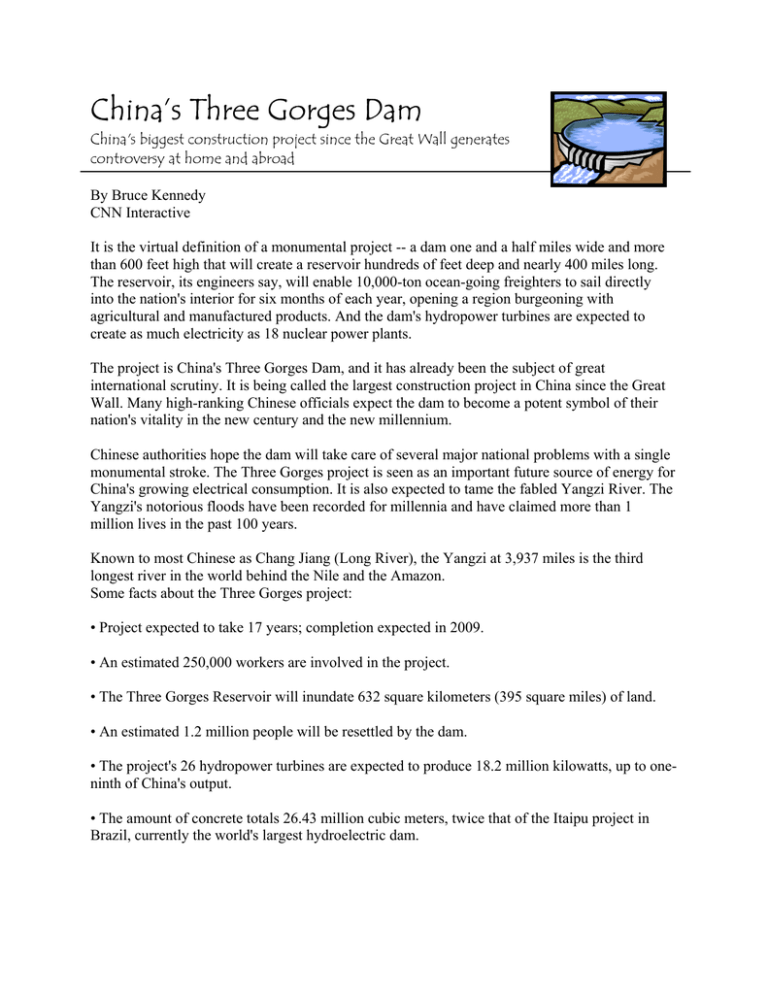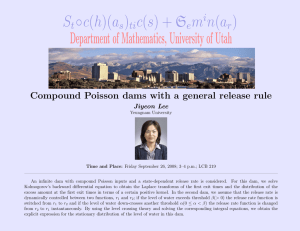China’s Three Gorges Dam
advertisement

China’s Three Gorges Dam China's biggest construction project since the Great Wall generates controversy at home and abroad By Bruce Kennedy CNN Interactive It is the virtual definition of a monumental project -- a dam one and a half miles wide and more than 600 feet high that will create a reservoir hundreds of feet deep and nearly 400 miles long. The reservoir, its engineers say, will enable 10,000-ton ocean-going freighters to sail directly into the nation's interior for six months of each year, opening a region burgeoning with agricultural and manufactured products. And the dam's hydropower turbines are expected to create as much electricity as 18 nuclear power plants. The project is China's Three Gorges Dam, and it has already been the subject of great international scrutiny. It is being called the largest construction project in China since the Great Wall. Many high-ranking Chinese officials expect the dam to become a potent symbol of their nation's vitality in the new century and the new millennium. Chinese authorities hope the dam will take care of several major national problems with a single monumental stroke. The Three Gorges project is seen as an important future source of energy for China's growing electrical consumption. It is also expected to tame the fabled Yangzi River. The Yangzi's notorious floods have been recorded for millennia and have claimed more than 1 million lives in the past 100 years. Known to most Chinese as Chang Jiang (Long River), the Yangzi at 3,937 miles is the third longest river in the world behind the Nile and the Amazon. Some facts about the Three Gorges project: • Project expected to take 17 years; completion expected in 2009. • An estimated 250,000 workers are involved in the project. • The Three Gorges Reservoir will inundate 632 square kilometers (395 square miles) of land. • An estimated 1.2 million people will be resettled by the dam. • The project's 26 hydropower turbines are expected to produce 18.2 million kilowatts, up to oneninth of China's output. • The amount of concrete totals 26.43 million cubic meters, twice that of the Itaipu project in Brazil, currently the world's largest hydroelectric dam. The father of modern China, Sun Yat-sen, is credited with first proposing the idea of a hydroelectric dam at Three Gorges in 1919. And in the mid-1950s, after devastating floods along the Yangzi, Mao Tse-tung ordered feasibility studies on damming the river. The project includes a system of locks, the largest ever built, intended to bring ocean-going ships 1,500 miles inland to Chongqing, the capital of the municipality created from Sichuan Province in 1997 to encompass the project. The municipality, with more than 30 million people, is under the direct control of the central government in Beijing. Officials hope the combination of inexpensive electricity and cheap river transportation will further open the region to international investment -- making Chongqing a major business center. The great expectations surrounding the Three Gorges Dam project also have generated a huge reservoir of controversy from within China and abroad. Concerns have surfaced about the dam itself. Allegations of corruption among officials involved with the project have raised fears of shoddy construction. The Chinese media recently reported several incidents in which corruption and poor construction have led to disasters at major building projects. Notable among the reports was the collapse of a steel bridge in the city of Chongqing in January 1999 that killed 40 people. Such incidents also have prompted rare open criticism from the Chinese leadership regarding the Three Gorges Dam. In early 1999 Chinese Premier Zhu Rongji inspected the dam site. He warned those involved in the project that "the responsibility on your shoulders is heavier than a mountain. Any carelessness or negligence will bring disaster to our future generations and cause irretrievable losses." Zhu also suggested China might invite top international engineers to inspect the dam and monitor its construction. Non-governmental criticism of the project also has surfaced. Journalist Dai Qing was jailed for 10 months in 1989-90 after criticizing the Three Gorges project and, by extension, Li Peng, the former Chinese premier and Soviet-trained engineer who spearheaded the dam's construction. Dai calls Three Gorges "the most environmentally and socially destructive project in the world." She also calls for a halt to construction and supports the idea of a series of smaller, less disruptive construction projects on tributaries of the Yangzi. Of further concern are claims the dam might become an environmental disaster. There have been little to no attempts made toward removing accumulations of toxic materials and other potential pollutants from industrial sites that will be inundated. Experts say such materials could leach into the reservoir, creating a health hazard. The relative lack of waste treatment plants in China also could mean run-off from communities around the dam would most likely go untreated directly into the reservoir and into the Yangzi. "By severing the mighty river and slowing the flow of its water, the dam will cause pollution from industrial and residential sources to concentrate in the river, rather than be flushed out at sea," writes Chinese journalist Jin Hui in "The River Dragon Has Come!" a recently published collection of criticisms against the dam. "The result will be a poisoned river." There are also claims that the dam will actually contribute to the silt accumulation in the Yangzi, rather than allow larger ships to travel the river. And others dispute whether the electricity generated by the dam will be efficiently used. "I think China has embraced an energy dinosaur," says Dr. John Byrne, director of the University of Delaware's Center for Energy and Environmental Policy. "In terms of an American scale, this dam is somewhat akin to the electrical load between Philadelphia and Washington D.C. being served from a single power plant." Byrne is skeptical whether the huge amount of electricity expected to be generated by the Three Gorges project -- meant to produce power for Chongqing and places as far away as Shanghai -can be efficiently and economically absorbed by China's electrical system. The social element of Three Gorges has generated more questions than answers. The dam will "drown" more than 100 towns once the water starts to rise in 2003. Government estimates say 1.2 million people will be resettled and that new land is being provided for 300,000 farmers. Some observers say the government may be underestimating by as many as 700,000 the number of people who actually will be relocated. The issue of the farmland, much of which has been tilled by the same Chinese families for centuries and will be lost under the reservoir's waters, is particularly important, Byrne says. "One of the tragedies of this [project], if just from a regional standpoint, is that the land that is going to be flooded is some of the most fertile in China," says Byrne. "The land to where the population is to be relocated is much less fertile." The frustrations of those caught up in the resettlement process have been well covered by the Chinese media. Even the People's Daily, the Chinese Communist Party's official newspaper, has editorialized against corruption and poor construction that have either delayed new housing or resulted in sub-standard buildings. Historians also have questioned the dam's impact on attempts to preserve some aspects of China's long and illustrious history. Archaeologists and historians have estimated nearly 1,300 important sites will disappear under the reservoir's waters. Most irreplaceable, according to some experts, are sites that are remnants of the homeland of the Ba, an ancient people who settled in the region about 4,000 years ago. A former curator at Beijing's National Museum of Chinese History describes the area as "the last and best place to study Ba culture." For its part, the government is well aware of the problems and challenges posed by the Three Gorges project. Nevertheless Guo Shuyan, deputy director of the Three Gorges Project Commission under the State Council, has described the project as "environmentally sound, on the whole." Chinese officials note the dam may end up providing as much as one-ninth of the nation's electrical production. Considering that China burns 50 million tons of coal each year for energy, their point is that the environmental benefits outweigh the environmental damage. It appears the Three Gorges project is too far along to be halted. More than 20,000 workers are working around the clock on the dam itself. The reservoir is expected to be at its full depth by 2009. Observers say China's leaders have too great a political investment in the dam's completion to ever contemplate backing away from the project. "The project's conception was monumental," says Byrne. "This was seen in the early years [of the project] as a way to show the advanced nature of Chinese society under socialism, to solve a problem that has existed in China for thousands of years... But when you're doing something on this scale, you should really make solving the problems your first priority. Unfortunately, China has decided to launch the project -- then solve the problems along the way."





